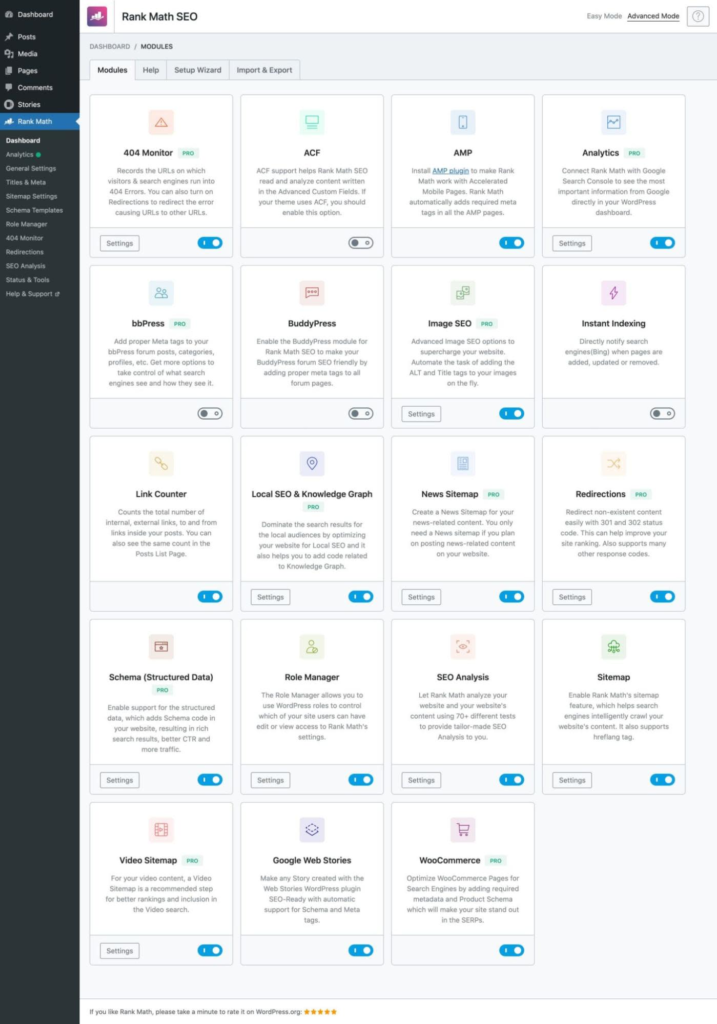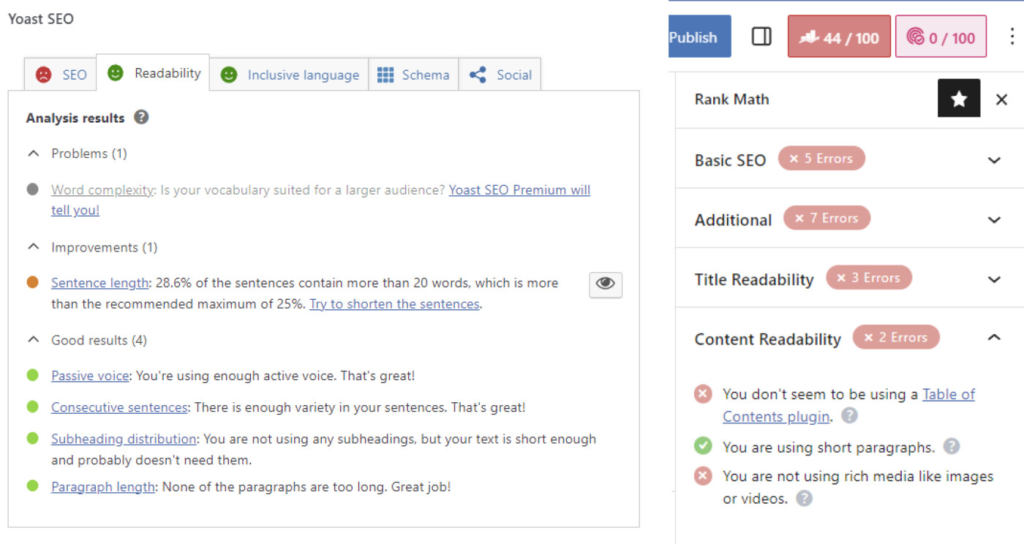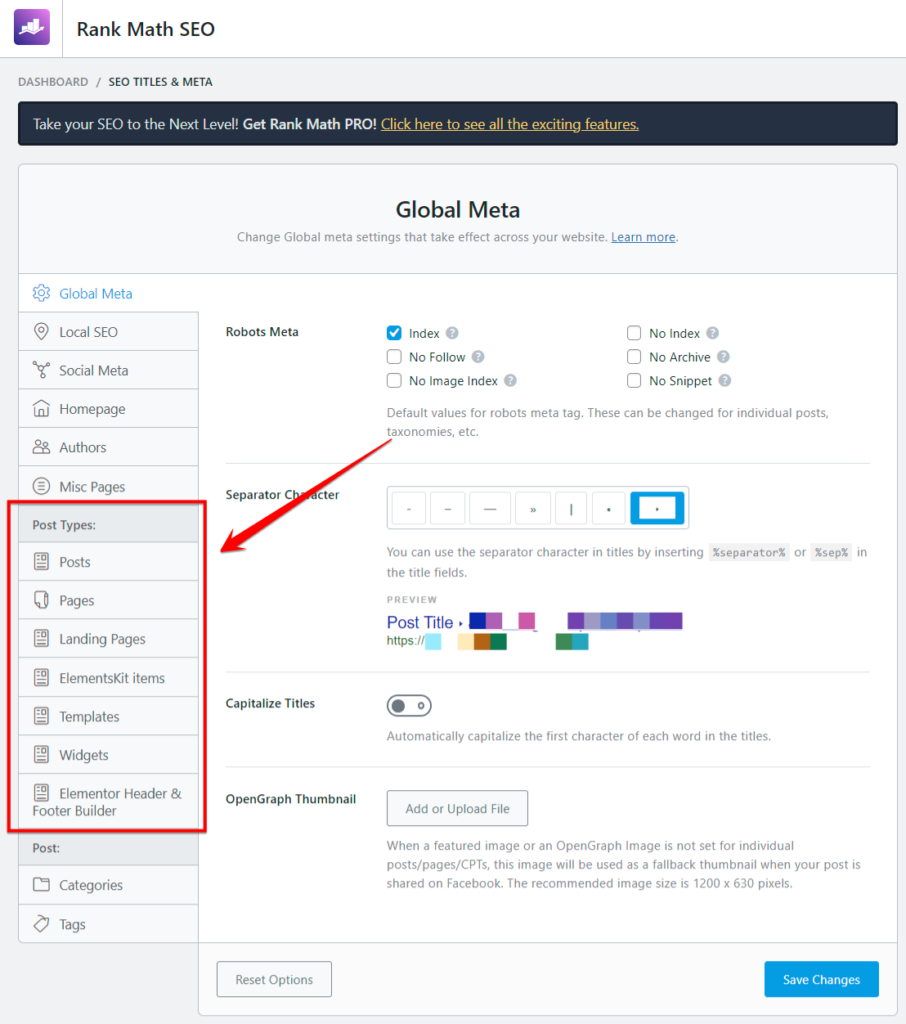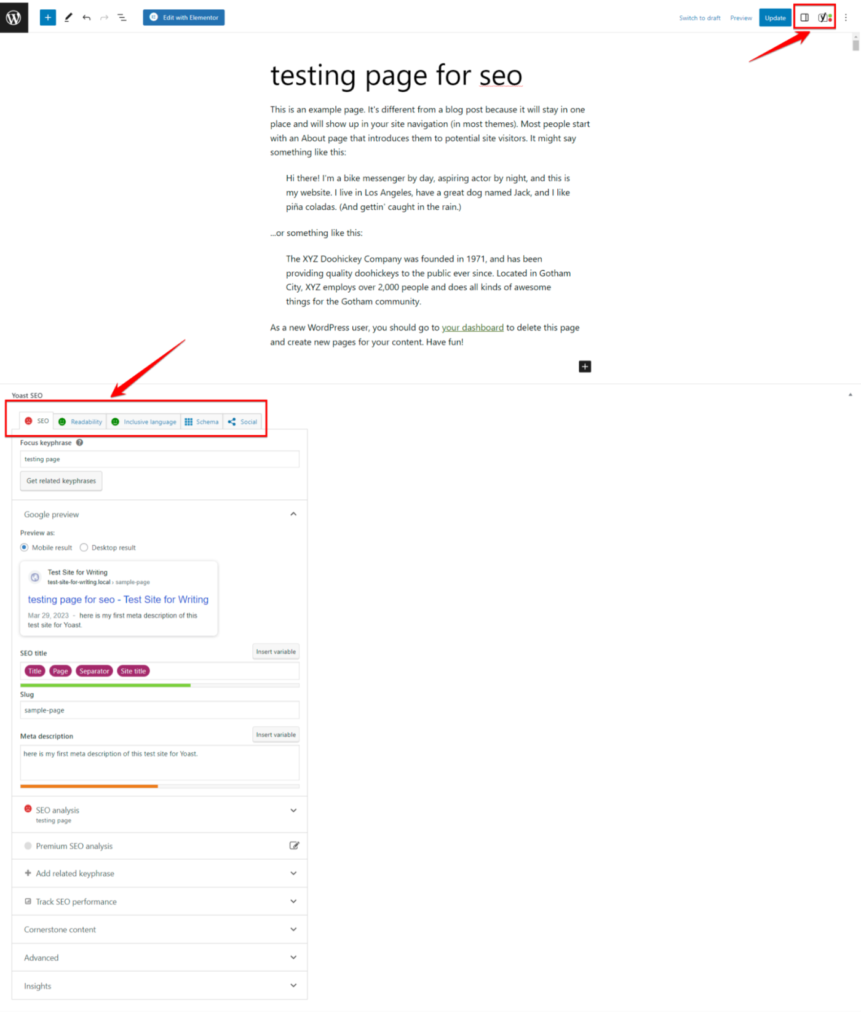Yoast SEO is the original WordPress SEO plugin and the undisputed best available. Swiftly ascending the charts is Rank Math which is presently ranked third among WordPress plugins for SEO.
Although I’ve used Yoast on my own websites, I hadn’t tried Rank Math before reading this article. I thus took the time to examine the functionality of these two WordPress SEO plugins, weigh their advantages and disadvantages, and assist you in selecting one for your website.
Rank Math vs. Yoast at a glance
| Yoast SEO | Rank Math | |
|---|---|---|
| Utilization ease | ⭐⭐⭐⭐⭐ lucid guidelines; strong illustrations | ⭐⭐⭐⭐⭐Simple to use and navigate; instructions are clear |
| Configuration | ⭐⭐⭐⭐ Good onboarding process; everyone can set it up easily | ⭐⭐⭐⭐⭐ Fantastic configuration with two presets (Advanced and Basic Modes) |
| Optimization of keywords | ⭐⭐⭐ Each page or post may only have one keyword; additional site keywords require a subscription. | ⭐⭐⭐⭐⭐ One keyword per post or page; a free account includes up to five site keywords |
| Popularity | ⭐⭐⭐⭐⭐ It has held the top spot for many years. | ⭐⭐⭐⭐ After just a few years, it has risen to #3 in the rankings. |
| Pricing* | ⭐⭐⭐ Free for one site; Pro costs $99 per site; package discounts are offered to owners of multiple sites. | ⭐⭐⭐⭐⭐ One website is free; unlimited personal sites cost $59; businesses and agencies can choose from additional options starting at $429 for 100 websites. |
*Each plugin’s free edition is limited to one site and one account per plugin. Of course, using separate accounts for each site would be a workaround, but in all honesty, that’s a lot more work than it’s worth. It’s simpler to choose a paid option and do away with the complexity if you’re a web designer or agency owner who oversees several websites.
Rank Math provides more features at no cost.
Rank Math provides numerous features out of the box for free and only charges a subscription for the service’s enhanced or advanced version. Rank Math free gives you access to features such as:
- Meta descriptions and SEO titles
- Descriptions on social media
- analysis of several keywords for every post or page
- Sitemap in XML
- fundamental local search engine optimization and schema
- Visual SEO
- Suggestions for internal links
- 404 display
- Redirects 302 and 301
- Simple SEO for WooCommerce
Because these features are modular, it’s simple to turn on or off the ones you won’t be using.

Many of these features are also available with Yoast SEO, but some—like multiple focus keywords per page or post, 301 and 302 redirects, and local SEO—are limited to the premium add-ons. Additionally, you will need to pay $79 a year for a separate plugin subscription in order to use the WooCommerce plugin. Similarly, Yoast Local SEO plugin carries an annual cost of $79 more.
Yoast does provide packages to help defray the price of these extra plugins. However, if you have no money to spare, it might not be much of a choice for you as Rank Math offers the same functionality for free.
Yoast’s readability analysis features are superior.
Yoast SEO is particularly good at its readability analysis; it separates the readability score from the total SEO score, which makes it easier to see how well your content is performing. Because readability is a factor in search engine rankings, this is a crucial metric. The easier it is to read and comprehend, the more proficient you will become.
Yoast SEO uses the Flesch-Kincaid Reading Ease test to evaluate the content of your writing, looking at things like sentence length, word syllable count, transition word usage, and the amount of passive voice you’ve employed. It also provides you with detailed advice on raising the score, so you’ll know precisely what to adjust and how.
Also, if you possess the inclusive language feature turned on, Seven factors are taken into consideration when analyzing your content: age, gender, appearance, disability and neurodiversity, and socioeconomic status.

There are two reasons why all of these readability elements improve your search engine ranking: Readability encourages readers to linger on your website longer by demonstrating that your content is simple to understand. When Google notices this, it determines that your website is worthwhile to recommend to others and raises it in the SERP.
Conversely, Rank Math comprises the readability score
You are unable to determine the performance of your content as part of its overall SEO score. It also only provides you with basic notes on how to make it better.
The same page I drafted on a test website is ranked differently by Yoast SEO and Rank Math as follows:

As you can see, Yoast helps me understand how my content reads better and provides me with specific advice on how to make improvements on my website. Instead, Rank Math shows a 2 Errors message along with some ambiguous information about the issue. I have to click the question mark icon to read a general help article on their website in order to get assistance to improve it.
Rank Math offers website builders additional global SEO options.
Any website owner or marketer can save a lot of time by setting global SEO options for every piece of content on their website. All of the pages or posts can have their baseline SEO settings set at once, and you can modify them one by one as needed. Furthermore, you are aware of just how customizable settings can get if you are using a website builder (such as Divi, Elementor, or Beaver Builder) on your WordPress website. Because you used a builder, editing each page or post on your website separately would become a full-time job. That’s why both Yoast SEO and Rank Math enable you to immediately set the default global SEO settings for posts and pages. With both plugins, you can set it up for your posts, other pages, and home pages. What sets Rank Math apart, though, is that it offers an even greater number of free global SEO configuration options for site builders and content types than Yoast—even more than the Yoast plugin that is paid for.
Rank Math integrates with several website builders in the version that is free. You’ll get extra global SEO settings to change more than just your home page, posts, and pages if you use any of these. On the main Settings page, Rank Math automatically displays the relevant settings if you have those themes or plugins installed on your website. Just tweak these as you would any other kind of content, and reap further SEO benefits.
For instance, you can set up SEO for landing pages globally in Rank Math if you use Elementor. You can set up SEO for widgets, templates, and more when you combine Elementor with the free Rank Math plugin, Elementor Header & Footer Builder.

If you use a site builder such as Elementor, Yoast does not allow you to add global SEO settings for widgets or templates. In the free version, Yoast only allows you to set the global SEO options for three content types: landing pages, posts, and home pages. Although Yoast SEO integrates with Elementor, unlike Rank Math, you can only set SEO options for specific pages.
It’s simple to see how well your pages and posts are optimized overall with both plugins.
Both plugins have a color-coded graphic on the main pages that indicates how things are going (green = good, yellow = needs improvement, red = bad).

Yoast displays the results using a colored dot. SEO and readability scores
(in two different columns, as indicated by the red and green dots in the screenshot above). One thing Yoast does a little better than Yoast is to display the two scores separately, which is a nice feature.
Your SEO score (out of 100) is shown by Rank Math, which color-codes it similarly to Yoast. Rank Math differs in that it incorporates the keyword, schema, and hyperlink data, even though it does not separate the SEO and readability scores. You can quickly assess how well-optimized the content is for both internal and external linking, which is another metric Google uses to assess content quality.

The SEO optimization level for each individual page is displayed in different places by both plugins.
It appears twice in Yoast SEO:
- The traffic lights next to the Yoast logo in the upper-right corner of the screen.
- At the bottom of the page, in the Yoast SEO box (scroll down from the content to find it).

With the total score located in the upper-right corner, Rank Math displays it on the right side of each individual page.

Which is better, Rank Math or Yoast?
After experimenting with all of Rank Math’s features and using Yoast SEO for a while, I can state with confidence that either is a good option for website owners. They complement excellent content well, boosting your website’s search engine rankings and drawing more visitors to your content. This is how I would explain it.
Select Yoast SEO if…
You want assistance with both SEO and the readability of your content.
Your website is not in English; at the moment, it supports eighteen other languages.
You’re interested in learning more about SEO (since Yoast offers both paid and free courses that are helpful for beginners).
Select Rank Math if…
You run more than one website.
You wish to scale more economically and test out a greater variety of SEO features for free.
For your website, you want more options for global SEO.
Although Yoast SEO is the industry veteran in WordPress SEO, Rank Math appears to be gaining ground on them. It has received five stars and more than a million downloads already. Do you plan to continue using Yoast or are you thinking about moving to Rank Math?


